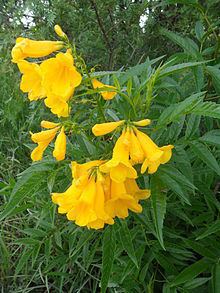Rank Genus | Species A. viminalis | |
 | ||
Similar Campsidium, Delostoma, Catophractes, Stizophyllum | ||
Astianthus is a monotypic genus of flowering plants in the Bignoniaceae family. The sole species is Astianthus viminalis. It is known by the common names achuchil in Mexico and chilca in Guatemala and Honduras.
Contents
Astianthus is native to Mesoamerica, from southern Mexico to Nicaragua. It is a shrub, or if larger, a tree of varying height, occurring mostly along streambanks from sea level to 1,200 m (3,900 ft) in elevation. Its leaves are unusually long and slender, resembling those of a willow, possibly because it is a rheophyte.
Description
The following description is excerpted from one that appeared in Flora Neotropica.
Taxonomy
The genus Astianthus was erected by David Don in 1823, in the Edinburgh Philosophical Journal. Don named its sole species Astianthus longifolia. He was apparently unaware that Karl Sigismund Kunth had previously named this species Bignonia viminalis in 1819. (The authority for this name is often cited as "HBK" instead of "Kunth". It is not clear why Alwyn Howard Gentry gives the date of the name as 1819.)
William Hemsley transferred this species to Tecoma as T. viminalis in 1882, recognizing that the specific epithet of Kunth had priority over that of Don by the rules of botanical nomenclature.
The name Astianthus viminalis is often accredited to Henri Ernest Baillon in volume 10 of his Histoire des Plantes, but the reason for the citation is not self-evident upon viewing page 44 of this work.
Older works have usually placed Astianthus in the tribe Tecomeae, but the circumscription of that tribe was greatly revised in 2009. Astianthus is now usually placed in Bignoniaceae incertae sedis. Alwyn Howard Gentry called Astianthus "a very isolated genus with no obvious affinities" and further wrote that "the superficial resemblance to Chilopsis is apparently due to parallel evolution for the same type of riparian site".
Astianthus has not yet been sampled for DNA in a molecular phylogenetic study.
Uses
Where Astianthus approaches its largest size, useful lumber can be produced from it, but it is rarely harvested by lumberjacks.
As with almost every plant, medicinal value has been alleged, but no verifiable evidence of efficacy has been observed. Isolated compounds and a crude extracts from Astianthus have failed to show any antimicrobial activity. They also showed no cytotoxicity for tumor cells.
Phytochemistry
The pentacyclic triterpenoids ursolic acid and oleanolic acid have been extracted from Astianthus. So have cinnamic acid, p-methoxycinnamic acid, and stigmasterol.
A chloroform-ethanol gradient elution High-performance liquid chromatography system was used to extract the iridoid glycosides campenoside and 5-hydroxycampenoside.
